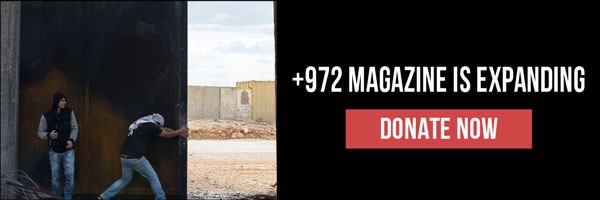The story of David and Goliath is a central Zionist myth. The case of Ahed Tamimi shows that while Israel still thinks it’s David, in reality, it’s Goliath.
By Gil Gertel

After the images from Nabi Saleh surfaced earlier this week, Minister of Education Naftali quickly made himself judge, jury, and executioner, declaring that the two Palestinian girls “should spend their lives in prison.” But why? Young Israeli settlers routinely disrespect soldiers and flout the rule of law. And that’s exactly the point: Ahed Tamimi did what’s reserved for Israeli settlers alone.
What, for Israelis, was most embarrassing about the pictures of Ahed Tamimi slapping an Israeli soldier? A woman hitting a man? A Muslim hitting a Jew? A civilian hitting a representative of law and order? A student hitting a trained fighter? That with her bare hands she hit someone fully armed and armored? That she hit the force that denies her rights? From the responses on social media, it seems all of the above. Ahed Tamimi flipped the traditional roles in the myth of David and Goliath, which was and remains a foundational myth of Zionist education.
The “new Jew” according to the story of David and Goliath appears in Theodore Herzl’s 1902 utopian novel Altneuland. At the beginning of the story we meet David, “a poor boy, freezing in the cold with tattered shoes,” a beggar in the alleyways of Vienna. After 20 years, we meet David again, this time in Haifa: “a free man, healthy, educated, serious-minded,” respectable and respected by mankind. How did this switch happen?
In his 1903 essay, “Hebrew Education,” Ze’ev Jabotinsky writes, “there was an instance in Odessa when we prepared for a pogrom. I was one of the scouts, and with a group of two other friends I wandered through the markets for signs that something had gone wrong.” During these outings, when passing through the masses of local people, “we would try to put on our best Russian expressions, and speak with a Muscovite accent.” Not out of fear, Jabotinsky recalls, but out of habit of hiding their Jewishness. At the end of the street he encountered an old Jewish peddler, with a beard and side-locks, dressed in the traditional long, black coat. The old man looked terrified of the mass of people, yet he did nothing to hide his Jewishness.
“He who was afraid,” Jabotinsky writes, reflecting on the experience, “saw himself in that moment as freer than all of us. We, perhaps, were unafraid, yet we hid instinctively what he had revealed for all the world to see.” The old man, even in a moment of terror, held fast to his Jewish identity, while they, in theory, had compromised theirs. The moral of the story has become the core of Jabotinsky’s educational philosophy: “a national basis is presently needed as the center of the education of Jewish youth, in order to excise self-hatred and revivify national self-esteem.” Revivify national self-esteem: is this not also what Ahed Tamimi did?
All of the streams of Zionist thought shared the idea of Jewish pride, which occupied a central place in the state of Israel’s first educational curriculum in 1954. Teachers were asked “to provide student with the knowledge that our people, among the smallest of the nations, refused to submit to stronger nations and their cultures.” Refusal to submit. Ahed Tamimi?
This is not just a historical matter. Seventy years of independence, with a victorious and conquering army, and we still have not weaned ourselves off the need for national pride. For this reason, students receive a distorted historical mishmash of David, Judah Maccabee, and the war of independence. This year, the Ministry of Education’s Hanukkah web page states, “if we had been in David Ben-Gurion’s position, a minority against a majority, weak against strong, and the realistic chances of success were zero, would we have embarked on this historical process? Or would we have followed reason’s recommendations and opposed the creation of the state? From Hanukkah we learn that if we just take that first step, a miracle will occur. We need to do all that we can not to be merely satisfied with the present.” Not to be satisfied with the present? Is this not what Ahed Tamimi showed?
A year ago, the educational TV channel produced a series on the Bible that included an episode on David and Goliath, to be used in the school system. In the video, Tzvika Hadar explains to the students:
It is not a coincidence that the fight between David and Goliath has become a symbol of fights between unequal sides. How many fights like those there were, even here! 1948: the small state of Israel, not even a day old, was attacked by the massive armies of Syria, Egypt, Jordan, Lebanon, Iraq, Saudi Arabia. And Israel, this tiny country with a brand new army, the few against the strong and the many…but in this war David defeated Goliath.
This is not the place to point out the historical inaccuracies in the text, but to emphasize the message: the small and the daring won. Ahed Tamimi?
Since we’re already making a mess of history, we can’t forget the Holocaust. Here are Naftali Bennett’s remarks at a ceremony commemorating the Warsaw ghetto uprising: “We might ask what was the sense in a rebellion that never stood a chance…the few against the many fought a hopeless struggle for Jewish people’s national honor.” National honor—Ahed Tamimi?

Here’s more of what appears on the Ministry of Education’s website. This time, a social studies lesson plan for high school students on Jewish courage for the occasion of Hanukkah: At a forced labor camp for women during World War Two, women improvised a hanukiyah, which they lit with what little oil they could find. One night, the siren to turn off the lights rang before the candles had gone out. The candlelight exposed them, and an SS guard broke into the room, shouting threats. The women explained to her that they were commemorating the holiday of the Maccabees, when “a few Jews defeated many gentiles.” And here was the miracle: not only were they not punished that night, but they even received more respectful treatment from the guards in the days that followed. In light of the story, the students are asked to clarify the meaning of courage, and the teachers are instructed to conclude: For us, as Jews, courage is the triumph of the spirit. Triumph of the spirit—Ahed Tamimi, or is that only for “us, the Jews?”
Finally, last Friday morning, just a few hours after Ahed Tamimi made headlines, the settler newssite “Srugim” published a Hanukkah song by Ronit Shir. Here are two verses of the song:
Few against many, / weak against strong. / Seeing the image of their father Abraham, / leading his charges against the world’s might. / Their quivers are empty, no arrows remain. / They put a few stones in a slingshot / Analysis says their fight is lost. / The fight of Abraham, the brothers, surely Maccabees. / But against the voice of reason stands “Jewish reason.” / That works a little differently; it’s more about faith. / Ignores the calculation of chances / and puts its trust in God. / Together with increased spirit, belief and vision / it turns out you don’t always have to listen to the voice of reason.
Whose “quivers are empty,” really, in the occupied territories? If you read the song reasonably, it describes Ahed Tamimi much more than the armed and armored in the settlements — and for this, Naftali Bennett will never forgive her.
Gil Gertel is a scholar of education and a blogger on Local Call, where this article was first published in Hebrew. Read it here.

